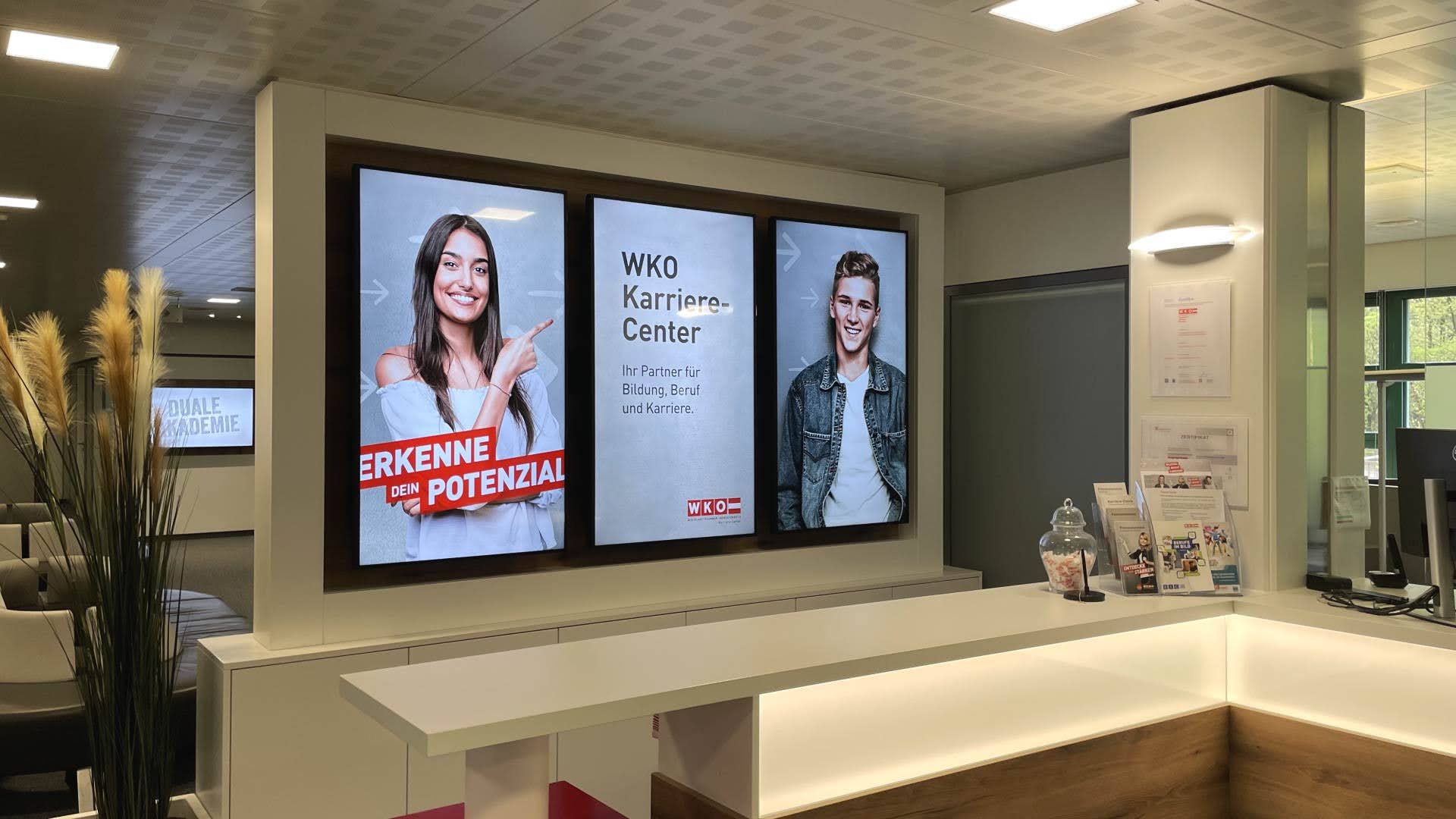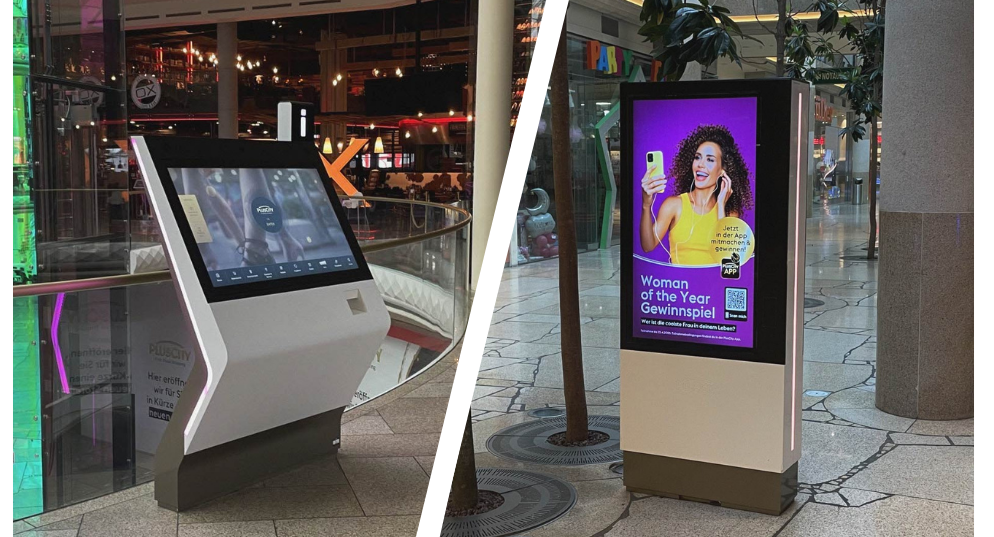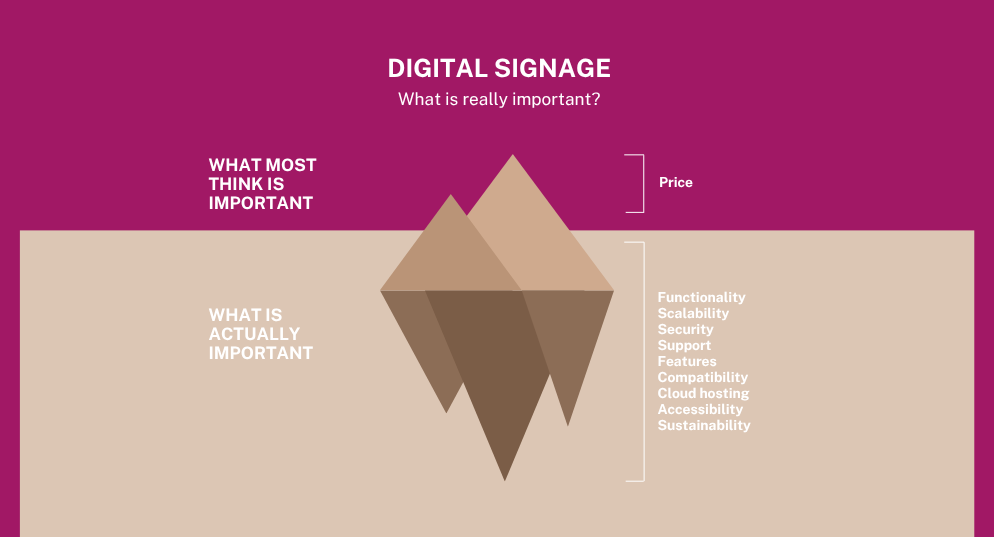What is DIGITAL SIGNAGE?
DEFINITION, ADVANTAGES & EXAMPLES
In this article:
- What is Digital Signage Software and how do the applications work?
- These are the advantages
- Needs assessment: Strategy & requirements
- Calculation example: What about the costs?
- The future impact
In a nutshell: What is digital signage software, how does it work and what are the benefits?
Digital signage is a solution for displaying content such as advertising, information and messages. Digital signage is hosted via a cloud or on-premise and is used across industries with various hardware applications such as customer stoppers or shop window displays. The benefits include cost efficiency, time savings and an improved user experience.

Digital signage definition
Digital signage solutions are screens that display image and video material in a compact form. However, the term “digital signage” does not only include display advertising, as the systems are also used for communication, presentations and visitor management.
How does digital signage work and what is required?
Digital signage requires hardware, i.e. a computer device to prepare content, as well as a memory and a display to play the content. The digitally and visually networked information is imported, updated and finally displayed on the screen using software. By using a cloud solution, the content is stored and played at any time and from any location.
-> But: Digital signage does not necessarily have to run via a cloud. For companies with high security standards, on-premise solutions are often the better choice.
Digital Signage: These are the advantages
- Cost reduction compared to conventional advertising media
- Flexible adaptation of content in real time
- Better customer experience and self-service through interactive displays
- Accessibility through voice output and automatic translations
- Improved brand perception
- More sales through targeted advertising
- Energy-efficient use
Example for digital signage advantages: Digital signage at our customer “PlusCity”
In PlusCity, stores have to be flexible – for example, when it comes to short-term discount promotions or new campaigns that need to be displayed at peak times. This shows how digital signage makes real-time adjustments possible and at the same time significantly reduces the effort compared to print.
Thanks to sensor-based technology by FRAMR., the system automatically recognizes when target groups are active – so different content is displayed in the morning than in the afternoon in order to address target audiences effectively. PlusCity itself relies on centrally positioned interactive displays (see left image below), which visitors can use to search for stores or products independently (better self-service).
-> For comparison: Classic posters would be at a clear disadvantage here – simply because of the more than 200 stores in the shopping center. Printing costs, installation and the lack of flexibility to make changes at short notice make them more expensive than a digital signage solution in the long term. In addition, statistics show that digital displays are seen up to 400% more often than print – primarily due to their moving and interactive content, which actively shapes the brand image.
 Our customer “PlusCity”. On the left, an interactive display for independent navigation. On the right, a classic advertising stele.
Our customer “PlusCity”. On the left, an interactive display for independent navigation. On the right, a classic advertising stele.
What are the disadvantages of digital signage?
The implementation of digital signage takes some time. Displays need to be set up and your team may not have any expertise in using the software or how to create content with it. Depending on where you are from, there are also potential legal hurdles to consider, including GDPR, competition law and licenses.
Concrete application possibilities of digital signage systems
- Application areas
- Advertising (indoor, outdoor)
- Price board
- Interactive displays
- Recruiting
- House notice board
- Welcome sign
- Information board
- LED wall
- Customer stopper
- Signposts
Industry-related areas of application
- Gastronomy and hospitality: Menus, self-service, branding, atmosphere
- Retail: self-checkout, product search, advertising, branding
- Tourism: immersive content, communicating occupancy rates (e.g. for massages), advertising
- Companies: Employee communication, presentations
- Healthcare and medical practices: patient information, hygiene regulations
- Waiting rooms: visitor management, entertainment, information
- Cinemas and entertainment: advertising, immersive content, visitor management (e.g. at the snack stand in the cinema)
- Public institutions: Audio playback, multilingual content for international museum visitors, interactive information provision
Examples: This is what it looks like in practice
Case Studies
Are you looking for practical insights into the use of digital signage? Our case studies show concrete solutions and customer projects.
Strategy and requirements
Companies should address one question in particular: What are the prerequisites for successfully using digital signage applications? And there are three key components here:
Determining requirements
Every company needs to know what it wants to use digital signage for and to what extent. The decisive factors here are not only the number of displays or which software to use, but also the personnel required for content creation, how often new content is needed or the extent to which the company wants to scale. Only then do questions about software installation and hardware procurement arise.
In terms of software and hardware, it depends on the individual requirements. Some companies already have hardware solutions and are looking for suitable, vendor-independent software. You should also consider whether you need an industry-specific solution. Other decision criteria are: Functionality, security aspects, business benefits, vendor support and scalability.
Strategy
Strategy is also an important aspect when determining requirements. Some companies use digital signage purely for advertising, others integrate the applications into an omni-channel marketing strategy – such distinctions must be taken into account. A functioning strategy takes into account questions relating to resources, areas of application, the timing of content playback and which target group you want to reach.
Requirements
In order to use digital signage in a targeted manner, a number of requirements must be observed. These include the following:
- Know your individual objectives and define KPIs to measure performance.
- Plan with a fixed budget to have more transparency regarding costs.
- Know your target group to find out the best content formats. Depending on the industry, certain content works better than other.
- As a team, think about which locations work best for digital signage applications to determine a targeted point of sale.
- Plan with test phases until your team is familiar with the applications.
- Be familiar with the individual requirements of your business. Every company is different, so the requirements for target groups, locations and budget planning are also different.

In our article “7 requirements for the use of digital signage”, we take a closer look at the requirements and what needs to be considered for a targeted implementation.
Sample calculation: What about the costs?
The price of digital signage depends on the equipment and which solution is most suitable for a company. But also on the provider: That’s why we can only speak for ourselves in the following calculation example. To give you an initial overview, here are three examples of the costs of FRAMR. Signage:
| Project example | Brief description | Cost estimate | |
| One-off | Ongoing, monthly | ||
| Restaurant | 3x 43” display with FRAMR. Android app for displaying menus and dishes of the day, content planning | approx. 2.400,00 € | 20,07 € |
| Outdoor advertising in front of the office building | 55” 24/7 outdoor advertising stele with double-sided display and FRAMR. Player PRO incl. network connection via LTE | approx. 6.700,00 € | 9,90 €
(excl. mobile data contract) |
| Retail chain with 10 locations across Europe | 30x 65” 24/7 display incl. FRAMR.Player SDM for displaying flash discounts, sales promotions and information on the customer bonus program. Remote maintenance with FRAMR. Player hardware possible. |
approx. 60.000,00 € | 267,00 € |
The future impact
The digital signage market will grow by 8% annually until 2030 (source). Those who do not invest in digital technologies will also find it more difficult to compete in the future, as target groups see digital signage systems as the new standard.
Current developments show that the technical potential is far from exhausted. There are more and more modules, barrier-free functions (e.g. automatic translations) and live streaming options. The development of artificial intelligence also plays a role (e.g. sensor-based technology for evaluating customer behavior).
-> For companies, this means that they can make their marketing processes more measurable, minimize wastage and integrate digital signage into an omni-channel marketing strategy.
This also increases complexity and companies face more challenges. The development of AI functions in particular is changing market dynamics and companies need to become more flexible and learn how to use new technologies. Progress promises more advantages, but this also changes the requirements and prerequisites. In this respect, companies need to plan more resources and continue to monitor market developments.
